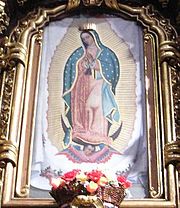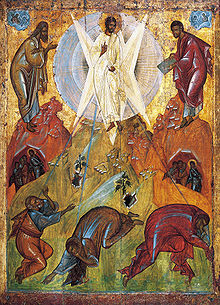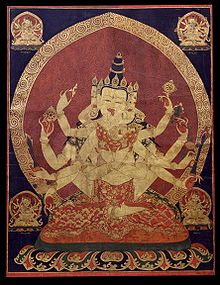- Aureola
-
 18th century Eastern Tibeten thanka, with the Green Tara (Samaya Tara Yogini) in the center and the Blue, Red, White and Yellow taras in the corners, Rubin Museum of Art
18th century Eastern Tibeten thanka, with the Green Tara (Samaya Tara Yogini) in the center and the Blue, Red, White and Yellow taras in the corners, Rubin Museum of Art
 Images of Mary, mother of Jesus, are often surrounded by an aureole, as in this image of Our Lady of Guadalupe.
Images of Mary, mother of Jesus, are often surrounded by an aureole, as in this image of Our Lady of Guadalupe.
 The Buddha (with the legend "BODDO" in Greek script) with an aureole enveloping the whole body, on a coin of the Kushan king Kanishka, 2nd century AD.
The Buddha (with the legend "BODDO" in Greek script) with an aureole enveloping the whole body, on a coin of the Kushan king Kanishka, 2nd century AD.
An aureola or aureole (diminutive of Latin aurea, "golden") is the radiance of luminous cloud which, in paintings of sacred personages, surrounds the whole figure. In the earliest periods of Christian art it was confined to the figures of the persons of the Christian Godhead, but it was afterwards extended to the Virgin Mary and to several of the saints.
 Russian icon of the Transfiguration. Jesus is shown surrounded by a light blue aureola with white flashes of lightning (15th century, attributed to Theophanes the Greek, Tretyakov Gallery, Moscow).
Russian icon of the Transfiguration. Jesus is shown surrounded by a light blue aureola with white flashes of lightning (15th century, attributed to Theophanes the Greek, Tretyakov Gallery, Moscow).
The aureola, when enveloping the whole body, generally appears oval or elliptical in form, but occasionally circular or quatrefoil. When it appears merely as a luminous disk round the head, it is called specifically a halo or nimbus, while the combination of nimbus and aureole is called a glory. The strict distinction between nimbus and aureole is not commonly maintained, and the latter term is most frequently used to denote the radiance round the heads of saints, angels or Persons of the Trinity.
This is not to be confused with the specific motif in art of the Infant Jesus appearing to be a source of light in a Nativity scene. These depictions derive directly from the accounts given by Saint Bridget of Sweden of her visions, in which she describes seeing this.[1]
The nimbus in Christian art first appeared in the 5th century, but practically the same motif was known from several centuries earlier, in pre-Christian Hellenistic art. It is found in some Persian representations of kings and gods, and appears on coins of the Kushan kings Kanishka, Huvishka and Vasudeva, as well as on most representations of the Buddha in Greco-Buddhist art from the 1st century AD. Its use has also been traced through the Egyptians to the ancient Greeks and Romans, representations of Trajan (arch of Constantine) and Antoninus Pius (reverse of a medal) being found with it. Roman emperors were sometimes depicted wearing a radiant crown, with pointed rays intended to represent the rays of the sun.
In the circular form the nimbus constitutes a natural and even primitive use of the idea of a crown,[citation needed] modified by an equally simple idea of the emanation of light from the head of a superior being, or by the meteorological phenomenon of a halo. The probability is that all later associations with the symbol refer back to an early astrological origin (compare Mithras), the person so glorified being identified with the sun and represented in the sun's image; so the aureole is the Hvareno of Mazdaism.[2][3] From this early astrological use, the form of "glory" or "nimbus" has been adapted or inherited under new beliefs.
Contents
Mandorla
A Mandorla is a Vesica Piscis shaped aureola which surrounds the figures of Christ and the Virgin Mary in traditional Christian art.[4] It is especially used to frame the figure of Christ in Majesty in early medieval and Romanesque art, as well as Byzantine art of the same periods. The term refers to the almond like shape: "mandorla" means almond nut in Italian. In icons of the Eastern Orthodox Church, the mandorla is used to depict sacred moments which transcend time and space, such as the Resurrection, Transfiguration, and the Dormition of the Theotokos. These mandorla will often be painted in several concentric patterns of color which grow darker as they come close to the center. This is in keeping with the church's use of Apophatic theology, as described by Dionysius the Areopagite and others. As holiness increases, there is no way to depict its brightness, except by darkness. In medieval Christianity, the mandorla generally represents the Ichthys, the wounds of Jesus, and Mary's birth canal which was the path by which Jesus entered the physical world.
The symbol is also used in non-Christian contexts. In various religions the almond seed has been associated with divine virgin birth. For instance the virgin nymph Nana miraculously conceived Attis by putting a ripe almond in her bosom.[5] [1]
In a famous romanesque fresco of Christ in Glory at Sant Climent de Taüll the inscription "Ego Sum Lux Mundi" is incorporated in the Mandorla design.[2]
Christ in majesty in a mandorla, surrounded by emblems of the evangelists: ivory plaques on a wooden coffret, Cologne, first half of the 13th century (Musée de Cluny)
The tympanum at Conques has Christ, with a gesture carved in romanesque sculpture, indicate the angels at his feet bearing candlesticks. Six surrounding stars, resembling blossoming flowers, indicate the known planets including the Moon. Here the symbolism implies Christ as the Sun. [3]
In one special case, at Cervon (Nièvre), Christ is seated surrounded by eight stars, resembling blossoming flowers. [4] At Conques the flowers are six-petalled. At Cervon, where the almond motif is repeated in the rim of the mandorla, they are five-petalled, as are almond flowers -the first flowers to appear at the end of winter, even before the leaves of the almond tree. Here one is tempted to seek for reference in the symbolism of the nine branched Chanukkiyah candelabrum. In the 12th century a great school of Judaic thought radiated from Narbonne, coinciding with the origins of the Kabbalah.[6] Furthermore, at Cervon the eight star/flower only is six petalled: the Root of David, the Morningstar, mentioned at the close of Book of Revelation (22:16) [5] (In one of the oldest manuscripts of the complete Hebrew Bible, the Leningrad Codex, one finds the Star of David imbedded in an octagon.)
In the symbolism of Hildegarde von Bingen the mandorla refers to the Cosmos.[7]
See also
- Aura
- Aureole effect
- Crown of Immortality
- Glory (optical phenomenon)
- Halo
- Heiligenschein
- Velificatio
References
- ^ G Schiller, Iconography of Christian Art, Vol. I,1971 (English trans from German), Lund Humphries, London, pp. 76-78 & figs, ISBN 853312702
- ^ Ramsden, E. H. (April 1941). "The Halo: A Further Enquiry into Its Origin". The Burlington Magazine for Connoisseurs (The Burlington Magazine Publications, Ltd.) 78 (45): , p. 131. JSTOR 868232.
- ^ Encyclopædia Britannica, 14th Edition, Vol. 15. Encyclopædia Britannica, Inc.. pp. 620.
- ^ Liungman, Carl G. (1991). Dictionary of Symbols. W.W. Norton. pp. 287. ISBN 0-393-31236-4.
- ^ Frazer, James G. (1922). The Golden Bough. Macmillan Publishing Company. pp. 403. ISBN 0-02-095570-7.
- ^ Scholem, Gershom (1990). Origins of the Kabbalah. Princeton Paperback. ISBN 0-691-07314-7. http://books.google.com/?id=9dRi8v-j7OMC&printsec=frontcover&q.
- ^ Riedel, Ingrid (1994). Hildegard von Bingen, Prophetin der kosmischen Weisheit. Kreuz Verlag, Zürich.
Further reading
- Timmers J.J.M. A Handbook of Romanesque Art New York London 1969 Icon Editions, Harper and Row
- Gérard de Champéaux, Dom Sébastièn Sterckx o.s.b. Symboles, introduction à la nuit des temps 3, Paris 1966 ed. Zodiaque (printed: Cum Permissu Superiorum)
- Brian Young The Villein's Bible; stories in romanesque carving London 1990 Barry & Jenkins
- Roger Cook The Tree of Life: Image for the Cosmos New York 1974 Avon Books
- Parry, Ken; David Melling (editors) (1999). The Blackwell Dictionary of Eastern Christianity. Malden, MA.: Blackwell Publishing. ISBN 0-631-23203-6.
Categories:- Religious symbols
- Christian iconography
- History of astrology
- Eastern Christian liturgy
Wikimedia Foundation. 2010.



